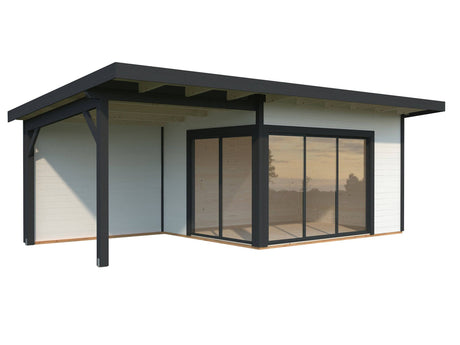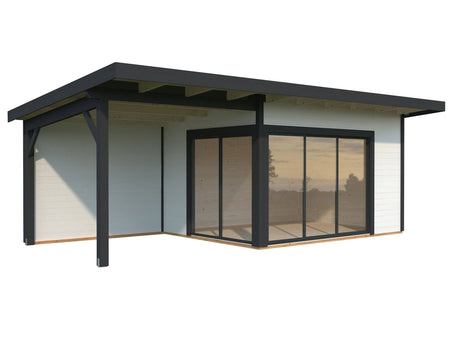When it comes to beautiful garden design most people fail to consider the importance of the garden path. A path can just be a simple route from A to B, but it can also be the backbone of your garden design. A path can transform the appearance of your garden and how it’s used. Either way, a creative garden path could hugely improve your garden.
The practical benefits of a garden path

Take the same route from your backdoor to your garden office, compost bin, shed or garage a couple of times daily, and in a rainy year, your lawn could look like a mud bath. In a bad November you may need wellies just to reach the garage.
The best way to rescue your lawn is to build a path. Not only will you avoid the trench effect, but you could make your garden look longer, wider and more interesting.
Unusual garden path ideas: create an optical illusion
There are lots of clever tricks of the trade when designing a creative garden path. For example:
- a path starting at 45 degrees from the house, and curving sinuously can make a garden look bigger and wider
- a tapering path that narrows at the end of the garden can make the whole garden look longer
- a path can steer the eye towards the garden’s best features, from an attractive garden building to a beautiful shrub. It can also create greater cohesion between your home and different garden buildings, or act as a divide, creating a route through different planting zones
- solar powered lights can highlight a path at night, or even change its colour
The best material for a garden path?

The crunch of a gravel path is always satisfying; other benefits of gravel include:
- it drains really well
- it’s good value for money
- it’s easy to lay
- it has a low environmental impact
- it can improve security (it’s very difficult to walk on a gravel path around a house without making noise)
And though gravel paths are not the most exciting option around, visual interest can be increased by breaking up the gravel with groupings of natural stone or granite slabs. Or you could try planting ground cover perennials, such as alchemillla (ladies’ mantle) in the gravel.
If you’re looking for other garden path ideas there are lots to choose from. Cheap materials for pathways include wood bark, pebbles, wood chips or stone chips, the last of these available in a wide range of colours.
If using coloured stone chips, remember that the colour will intensify when they are wet, so choose your shade with that in mind. You should also consider the impact of the stone colour on neighbouring plants too. Neutral colours can help blend a path into its surroundings, whereas a contrasting colour such as white granite or grey/blue slate will make the path stand out. Whatever you decide, if you use gravel, bark, wood or stone chips it’s best to put a layer of weed proof membrane underneath to minimise future maintenance.
There are a vast range of other possible materials for an interesting garden path; from traditional York stone (either new or salvaged), to recycled bricks, modern concrete, wooden sleepers or even raised decking. Decking can also add height to your walkway, which adds extra interest.
Each material has its pros and cons, in terms of price, durability, drainage, ease of use, and general appearance. You can get a good idea of what’s available in your budget range on the Jewson website.
Garden path edging ideas

Edging a path will prevent gravel or chips from migrating into the surrounding grass, and also make it look smarter. Possible edging materials include timber (which should be treated pleasure-treated with preservative), terracotta or slate tiles, or modern steel edging.
Again the choice will come down to price and taste. If you’re not sure, then visit as many gardens as possible to see what other people have used. Alternatively, look at websites such as Pinterest – there are some great examples of some really creative garden path ideas.
The best width for a garden path?

The best width for your path will partly depend on the size of your garden. Also entering your decision-making should be:
- narrower paths tend to encourage people to walk faster; broader paths offer more of an invitation to stroll
- generally, garden designers recommend a path is wide enough for two people to walk side by side, but a practical A-to-B path to a bin or shed can be narrower
- think about practicalities – whether you need enough width for a wheelchair or lawnmower, and if you should leave a gap in the edging to allow easy access for a wheelie bin or wheelbarrow
A straight garden path v. a curving garden path

The shape of the path depends on your taste and the space available. A meandering or curved garden path will generally make your garden look more interesting or bigger, but may not be practical if your family are likely to head for the bike shed or workshop by the shortest possible route.
Curved paths are also relatively easy to make yourself if you intend to use materials such as gravel or woodchip. However, you may need a professional garden landscaper to lay a curved garden path made of paving slabs or timber decking.
Straight paths are more likely to be used in larger, formal gardens, and may do little to enhance the design of a smaller garden. But if you want to add visual interest to an existing straight path, the options include:
- a pergola or arches to walk under
- a fountain, water feature or pond with a bridge to walk over
- interrupting the straight line by adding a paved area or bench part way along the path
- alternating between two different materials, such as mix of slabs and woodchip, or “stepping stones” slabs surrounded by gravel of a contrasting colour
The House and Home website has some inspirational and highly creative garden path ideas.
How to lay a garden path
There’s not the space here for a full tutorial on building a garden path, but there is plenty of good advice online. This video by Monty Don on the Gardeners World website covers all the basics.
There’s excellent guidance on building gravel, concrete or block paving paths on the Wickes website, and this also tells you all the materials you’ll need. From a spirit level to check that the base is level, to weed-resistant landscaping material for the base, to the right type of mortar.
If you follow these seven creative garden path ideas you could end up improving the look of your garden as well as making it feel bigger. You’ll also be rid of the quagmire that comes with winter weather too.






























































